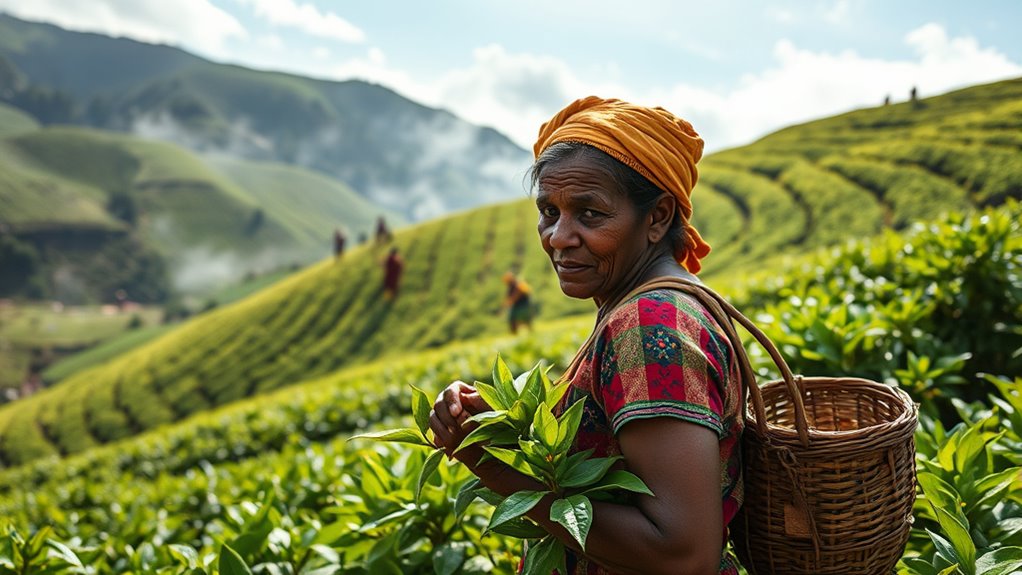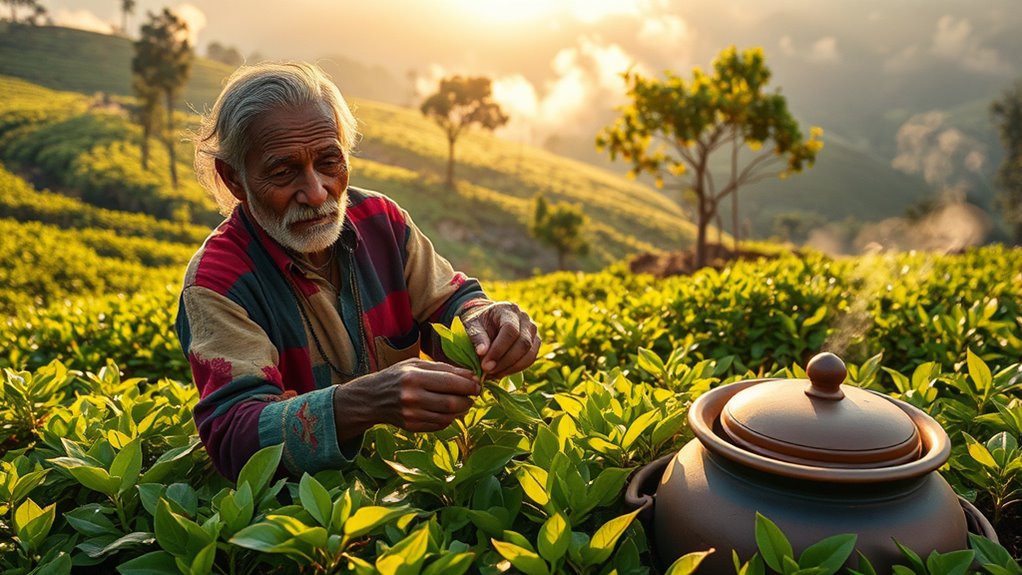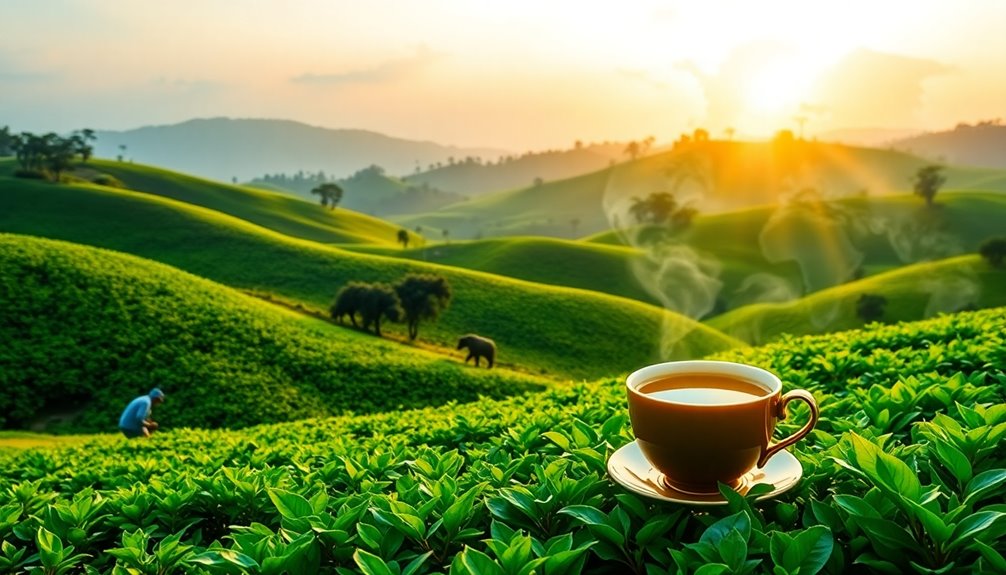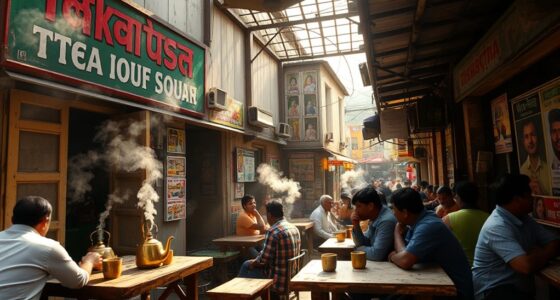In the Nilgiri Hills, tea pickers share stories that reveal a deep connection to centuries-old traditions, community pride, and cultural rituals. You’ll learn how their careful plucking techniques and shared customs aren’t just about harvesting—they’re a way to preserve identity and honor nature’s rhythms. Past and present blend as skills are passed down through generations, shaping the community’s spirit. Keep exploring to discover these voices that sustain the heart of tea culture in this scenic landscape.
Key Takeaways
- Tea picker stories reflect deep cultural traditions, rituals, and community bonds passed down through generations in the Nilgiri Hills.
- Voice accounts highlight the skill, patience, and careful techniques involved in traditional tea harvesting.
- Personal narratives reveal the significance of harvests as a cultural act that sustains community identity.
- Stories emphasize the adaptation of traditional methods to terrain and climate, blending heritage with modern innovations.
- Narratives showcase the emotional and social importance of tea picking as a shared cultural experience and livelihood.

Have you ever wondered what life is really like for the tea pickers who harvest your favorite brew? It’s a world filled with hard work, tradition, and a deep connection to the land. As you walk through the lush Nilgiri Hills, you begin to understand that harvesting tea isn’t just about picking leaves—it’s about preserving centuries-old cultural traditions and mastering specific harvesting techniques. These techniques are often passed down through generations, shaping the rhythm of life in these hills. You might notice how pickers carefully pluck the tender, bright green leaves with precise, gentle movements, ensuring only the best leaves are harvested. The process varies depending on the season, the type of tea being produced, and local customs. Some pickers employ a selective plucking method, choosing only the top two leaves and a bud, which demands skill and patience. Others may adopt a more general approach during busy harvest times, but the focus always remains on quality over quantity.
Cultural traditions play an essential role in how tea pickers approach their work. Many communities have rituals or superstitions associated with the harvest, believing that the way they pick the leaves influences the flavor and quality of the tea. These customs often involve prayers, songs, or gestures meant to bring good luck and ensure a bountiful yield. For some, tea picking is more than just a livelihood; it’s a communal activity that reinforces social bonds and cultural identities. You’ll see how these traditions help preserve a sense of pride and purpose among the workers, even as they face long hours and physical exhaustion. The shared stories and songs passed down through generations create a sense of continuity that ties the community to the land and their craft. Additionally, harvesting techniques are adapted to the terrain and climate of the Nilgiri Hills. Steep slopes and unpredictable weather require pickers to be agile and cautious, often working in small teams that rely on trust and coordination. Many workers learn their skills from family members or mentors, ensuring that these methods endure. Their work is a delicate balance of tradition and innovation, with some adopting modern methods to increase efficiency while still respecting age-old customs. As you reflect on this, it becomes clear that harvesting tea in the Nilgiris is more than a routine task—it’s a cultural act that sustains generations, blending age-old techniques with a deep-rooted respect for tradition.
Frequently Asked Questions
What Are the Traditional Methods Used in Tea Plucking?
You use traditional methods like hand harvesting and manual plucking to gather tea leaves. This involves carefully plucking the top two leaves and a bud with your fingers, ensuring quality and minimizing damage. These methods require skill and patience, allowing you to select the best leaves without harming the plant. By sticking to manual plucking, you preserve the tea’s flavor and tradition, maintaining the authenticity of the tea-making process.
How Do Seasonal Changes Affect Tea Picking in Nilgiri?
Seasonal changes considerably impact tea picking in Nilgiri. You notice that monsoon impacts delay harvest timing, as heavy rains make plucking difficult and affect leaf quality. During dry seasons, you can harvest more consistently, ensuring better quality and quantity. Understanding these seasonal shifts helps you plan your work effectively, adapting to the environment to maintain steady production despite changing weather patterns.
What Safety Measures Are in Place for Tea Pickers?
They say safety first, and that’s true for tea pickers. You’re protected by strict worker safety protocols and hazard prevention measures, like gloves, masks, and proper training. Regular health checks and ergonomic tools help prevent injuries. These measures guarantee you work safely and efficiently, emphasizing that protecting your well-being isn’t just a rule but a priority for the industry’s sustainability and your future.
How Has Tea Picking Technology Evolved Over Time?
You’ve seen how tea picking technology has evolved, moving from manual labor to automated harvesting systems. You might notice drones now assist in monitoring fields, improving efficiency and reducing labor. These innovations help you pick tea faster and more accurately, minimizing physical strain. As technology advances, you’ll likely see even more automated tools, making tea harvesting safer and more sustainable for everyone involved.
What Are the Health Benefits of Tea for Pickers?
You might wonder about the health benefits of tea for pickers involved in tea cultivation. Drinking tea can improve your focus and alertness, thanks to natural antioxidants and caffeine. It also helps boost your immune system and reduces stress. Regular tea consumption can promote better digestion and hydration. So, enjoying tea isn’t just a cultural tradition but also a way to support your well-being while working in tea cultivation.
Conclusion
As you reflect on these stories, remember that over 70% of tea pickers in the Nilgiri Hills are women, yet they earn less than half the minimum wage. Their voices reveal resilience amid hardship, highlighting the need for change. You can help by supporting ethical tea brands and advocating for fair labor practices. Every cup of tea you enjoy is connected to their labor—let’s guarantee their stories aren’t overlooked.










